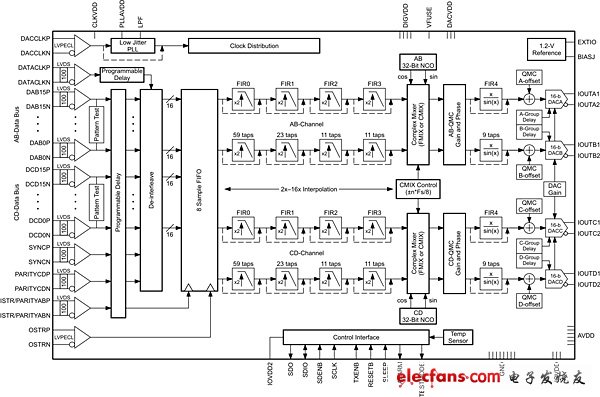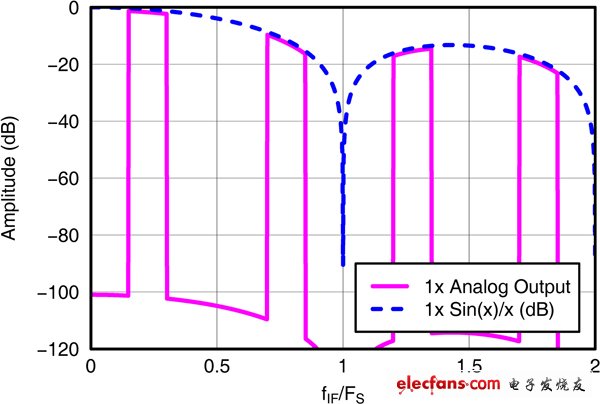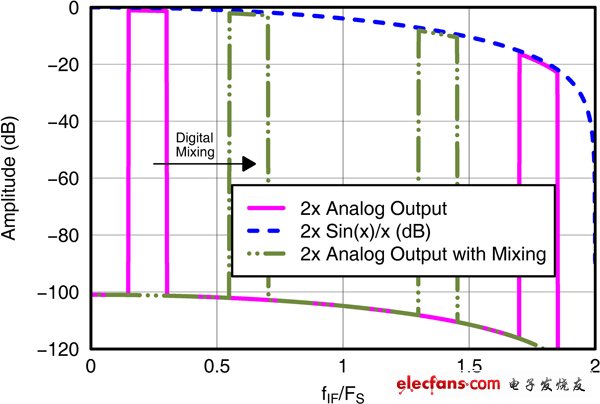TI's DAC34H84 is a 4-channel, 16-bit, 1250 Msps DAC. The reason for this is that it is a typical high-speed digital-to-analog converter with an input FIFO with isolated input and DAC clock domain, an interpolated digital block, fine frequency resolution digital quadrature modulation, analog quadrature modulator correction, and sin (x)/x correction (see Figure 1). This article will introduce the functions and functions of these features one by one.
The first digital block is the interpolation module, which is responsible for increasing the sampling rate of the digital signals inside the DAC. In general, interpolation is achieved using a double sampling rate increase step. This is done by inserting zeros between the input sample points, which produce two signals at fIF and FIN – fIF. After passing through a digital low-pass filter, the second signal at FIN – fIF is removed and only the signal is left at fIF. The reason for using interpolation is related to the zero-order hold output structure used by most high speed DACs. With zero-order hold, the DAC sets the output amplitude accordingly based on the digital samples at the beginning of the clock cycle and then holds it until the end of the clock cycle and the next output sample. This produces an "upstairs" output whose frequency response is expressed as Equation 1:

Figure 1 DAC34H84 functional structure diagram
Where fIF is the analog output frequency and fs is the sample rate. This response has a low-pass effect (see Figure 2) with a loss of ~ 3.5 dB at f = fs/2 and zero at fs multiples. Although the DAC output has a signal image at N*fs +/- fIF, the image amplitude in the higher Nyquist region is much lower than the signal at fIF, resulting in a lower signal-to-noise ratio (SNR). And there may be a significant amplitude drop. This limits most applications to output signal frequencies below fs/2. In addition, the spacing between the signal at fIF and the fs – fIF image decreases as fIF approaches fs/2, making it difficult to establish an analog filter at the DAC output (which removes fs – fIF unwanted images) and will eventually The fIF for most applications is limited to below fs/3.

Figure 2 DAC output spectrum without interpolation module
Use the DAC Interpolation Module to increase the internal DAC sampling rate by simply making the DAC's digital interface rate, fIN, high enough to allow signal bandwidth transmission, and with a small additional amount of bandwidth to have the interpolation filter transition band (real signal timing) 2.5*BW, when complex signal, fin > 1.25*BW). Using interpolation to increase the sample rate allows the signal to easily lie below fs/2.
Another benefit of increasing the sample rate is that digital mixing can increase the output IF to higher frequencies. For example, with 2X interpolation, the output frequency can be higher than fin/2, which is not possible without interpolation (see Figure 3). In general, complex input signals use a complex mixer to avoid image generation during mixing. The mixed output can be either a real IF signal or a complex IF signal, valid after the analog IQ modulator DAC.

Figure 3 2X Interpolated DAC Output Spectrum
Using the complex DAC output for an analog quadrature modulator (AQM) highlights another useful digital feature common to high-speed DACs—the quadrature modulator correction block. This module is responsible for correcting the gain, phase, and offset imbalance of the analog quadrature modulator to improve AQM sideband rejection and LO feedthrough.
Finally, at the end of the digital signal chain is a digital FIR filter that compensates for the Sin(x)/x high and low frequency regularity attenuation of the first Nyquist zone. In the DAC34H84 implementation, the filter can provide compensation up to 0.4*fDAC with an error of less than 0.03dB.
As described in this article, high-speed DACs such as the DAC34H84 have a large number of digital features. These features make system implementation simple and easy by reducing data rates and improving output signal characteristics.
08*16 2835 Led Neon Flex,Neon Flexible,Neon Flex Light,Neon Flex Led Strip
NINGBO SENTU ART AND CRAFT CO.,LTD. , https://www.sentuledlight.com
